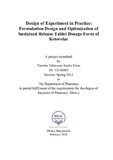Design of experiment in practice: formulation design and optimization of sustained release tablet dosage form of Ketorolac

View/
Date
2016-02Publisher
BRAC UniversityAuthor
Khan, Tanisha Tabassum SaykaMetadata
Show full item recordAbstract
Oral sustained release drug delivery system is being widely used for the past two decades as a means to provide a drug with improved therapeutic efficacy and also to assure rational drug therapy. The sustained release dosage form allows slow release of the drug followed by the maintenance of a constant therapeutic blood or tissue drug levels for an extended period of time. This characteristic of the dosage form further decreases frequency of drug intake ensuring better patient compliance and often reduces adverse effects associated with drug. The aim of the present study was to design and develop an optimized once daily oral sustained release matrix tablet formulation of a potent non-steroidal anti-inflammatory drug (NSAID), Ketorolac Tromethamine. Ketorolac Tromethamine has a short biological half-life of 4 to 6 hours, so it was considered as a suitable drug for the formulation of sustained release tablet to prolong its therapeutic action and reduce dosing frequency. The experiment was designed to develop nine different formulations of matrix tablets by using combination of hydrophilic Methocel K100M CR and Methocel K4M CR polymers at different ratios. The selection of the excipients was based on IR and DSC studies depending on the compatibility of which the tablets were manufactured by direct compression. The resulting tablets were evaluated for physical properties such as weight variation, hardness, thickness, friability and drug content which complied with the limits specified in USP. In vitro dissolution study was performed in order to obtain the drug release profile of the matrix tablets and the outcomes were fitted into various mathematical models for release kinetic analysis. Most of the formulated tablets were found to follow Higuchi drug release kinetics and exhibited non-Fickian type drug release mechanism. Furthermore, in order to obtain an optimum product, a 32 full factorial design was employed to systematically optimize the drug release profile with Design Expert software. The analysis of the responses produced by the software revealed that the polymer combination used at different ratios has control on the drug release. F4 was selected as the optimum formulation significantly on the basis of desirability criterion and graphical analysis.
